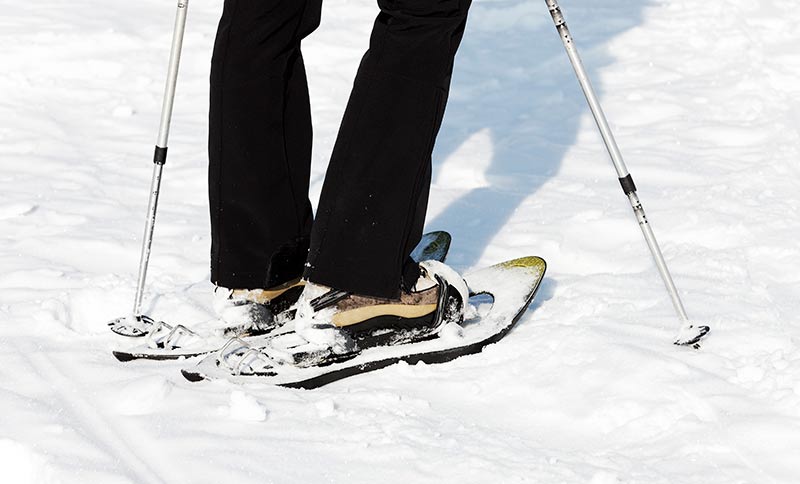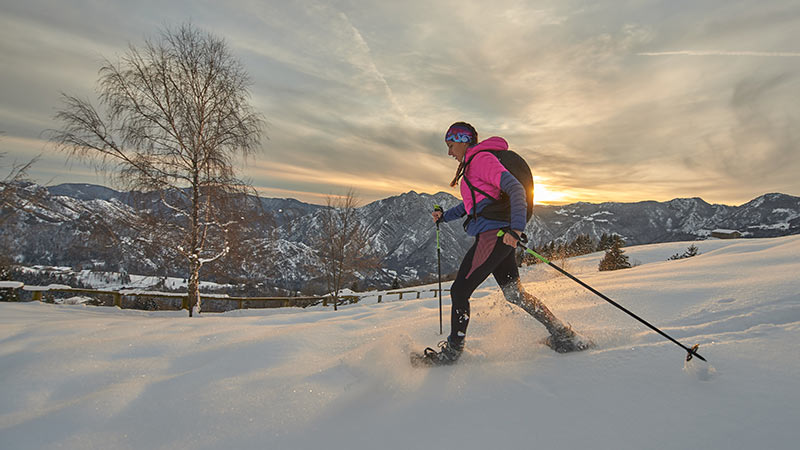Snowshoes work by distributing a person’s weight over a larger surface area to keep the person “afloat” much like a ship floats on water.
Without enough distribution, or any snowshoe at all, the snowshoer would sink straight through to the ground.
But a snowshoe provides the buoyancy to keep a person largely “on top” of the snow, making it easier to move through it.
“On top of the snow” is a bit of an inaccurate depiction, though.
While snowshoes do keep wearers from sinking all the way down to the ground, snowshoes really are just like boats.
Think of how a boat sits in the water.
Not on top of it, but with its bottom slightly submerged.
It sinks until it reaches buoyancy and then stabilizes.
That’s exactly how snowshoes work.
While how much a snowshoe sinks depends on a couple of main factors – how big the snowshoe is (how much surface area it has) and how packed the snow is – a snowshoe does sink into the snow MOST of the time.
Sometimes a little. Sometimes a lot.
That’s why, when it comes to snowshoeing, you have to account for sinkage and wait for sufficient snowfall.
How Much Snow To Snowshoe

You need at least 6 inches of snow to safely snowshoe.
Though, in this case, the term “safely” is more about the harm that might come to your snowshoes than any harm that might come to you.
When snowshoeing on fresh, powdery snow, you can expect to sink six inches. (How much you’ll sink is highly dependent on the type and size of your snowshoes and the conditions of the snow, but six inches is a good average number to use.)
This means, if you go snowshoeing in six inches of snow or less, it’s possible you will sink all the way to the ground.
Snowshoes are not designed for use on solid ground.
In fact, walking in snowshoes on solid ground can damage them, especially if they come into contact with typical ground debris and obstacles, such as rocks and roots.
In less than six inches of snow, not only do you not need snowshoes (it’s actually easier to walk in these smaller amounts of snow without them), but you risk damage to your shoes.
When Is Six Inches Not Enough?
While six inches is a good minimum accumulation for snowshoeing, there are times when six inches still isn’t enough.
If you have the smallest size snowshoe for your weight and the snow is very powdery, you may sink more than six inches. (It’s actually very likely.)
While there is no easy way to know how much you will sink in a certain snowfall other than by trial and error, if you are sinking to the ground with each step while snowshoeing, you need one of two things – a bigger snowshoe with greater weight distribution or more snow.
It doesn’t matter which of these two things you choose.
But if your snowshoes are hitting the ground with every step, you shouldn’t be wearing them.

Be Good to Your Snowshoes and They’ll Be Good to You
It can be hard, I know.
You wait all summer and early fall and that first snowfall of the year hits and all you want to do is grab your snowshoes and hit the trails.
But less than six inches of snow just isn’t good for your snowshoes.
So, instead of pushing your snowshoes to perform in less than ideal conditions, hang back and wait for sufficient accumulation.
You’ll have a better experience while you’re out snowshoeing, and your snowshoes will thank you for it.
